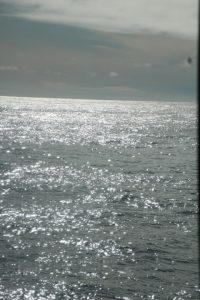At daybreak we were well into the voyage to Cape Horn at 53° S 63° W on another steely grey sea and this time wrapped in fog with an air temperature of 9 C.
During the late afternoon the sun reappeared and by sunset we had entered the Magellan Estuary. Land on both sides of the ship is still in the distance. Nearer to us are lines of oil production platforms burning off unwanted gases.
Whilst we were dining this evening we saw several whales and a little later, a pod of dolphins very close to the ship.
Our first landfall in the region and deep into Tierra del Fuego is Punta Arenas (Chile). To achieve this we have to navigate the Strait of Magellan. In 1520 when he passed through the then unnamed strait he had little interest other than gaining access to the Pacific and a new route to the Spice Islands of SE Asia. He had no contact with the Fuegian indigenous people other than spotting their camp fires and gave the area the name ‘Land of Fire’ in Spanish Tierra del Fuego. He finally entered the Pacific Ocean as we will do in a few days time.
European settlement brought a rapid demise of the Fuegians. On the voyage of the Beagle, with Darwin on board, Captain Robert Fitzroy abducted a few of the local Yaghans and returned with them to the UK in an attempt to educate them and return them as ‘missionaries’ as British interests in the region developed.
The Strait by now had become a major maritime thoroughfare for the Pacific trade being slightly more protected by its geography than the exposed Cape Horn route which was used by the speedy ‘clipper’ sailing ships.









